Abstract
1. A method is presented for identifying and estimating the aminoethylphosphonate (ciliatine)-containing phospholipids in a complex mixture. 2. Evidence was obtained that the phospholipids of a pure culture of Entodinium caudatum and a mixed rumen protozoa sample contain diglyceride ciliatine, and a plasmalogen ciliatine was detected in the latter. 3. A ninhydrin-positive sphingolipid was isolated from rumen protozoa. Although chromatographically homogeneous on silica gel it contains two components, which were provisionally identified as ceramide ciliatine and ceramide phosphorylethanolamine. 4. A detailed phospholipid analysis of E. caudatum and rumen protozoa is presented. They contain no phosphatidylserine or cardiolipin, but an unidentified phosphoglyceride containing a zwitterionic amino acid is present.
Full text
PDF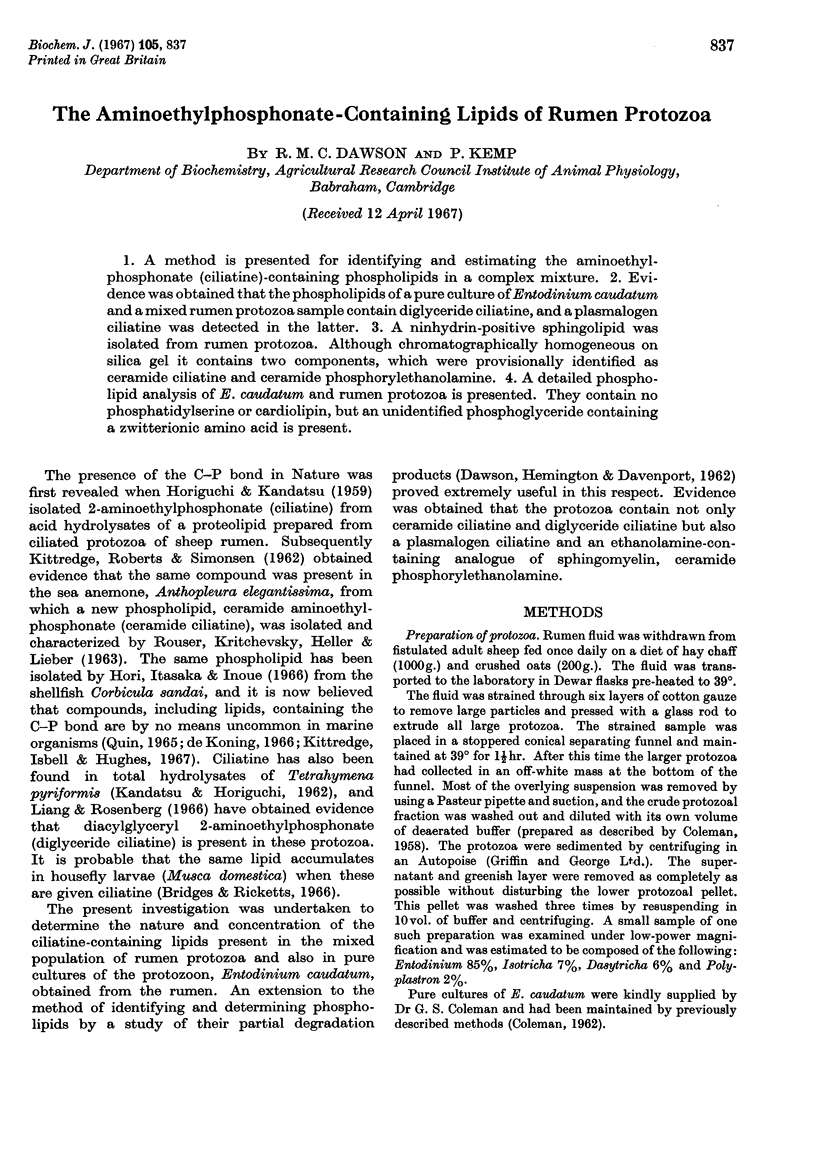
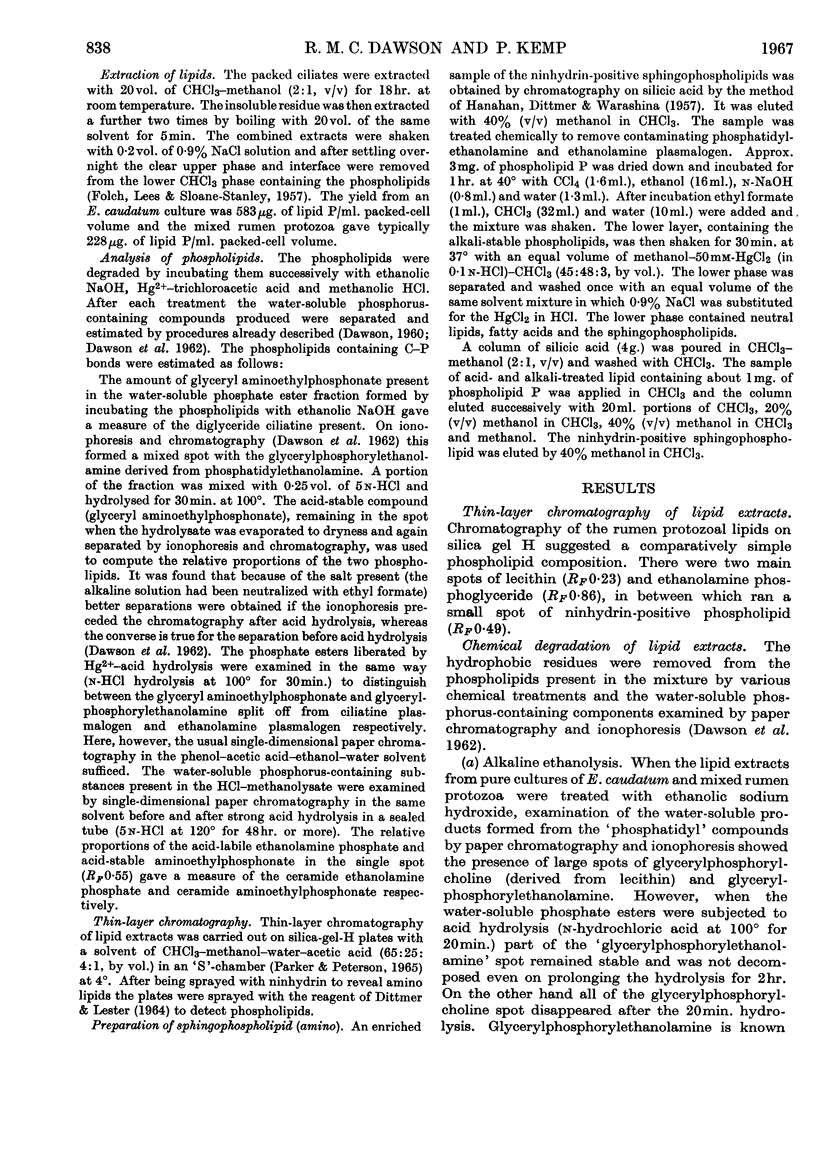

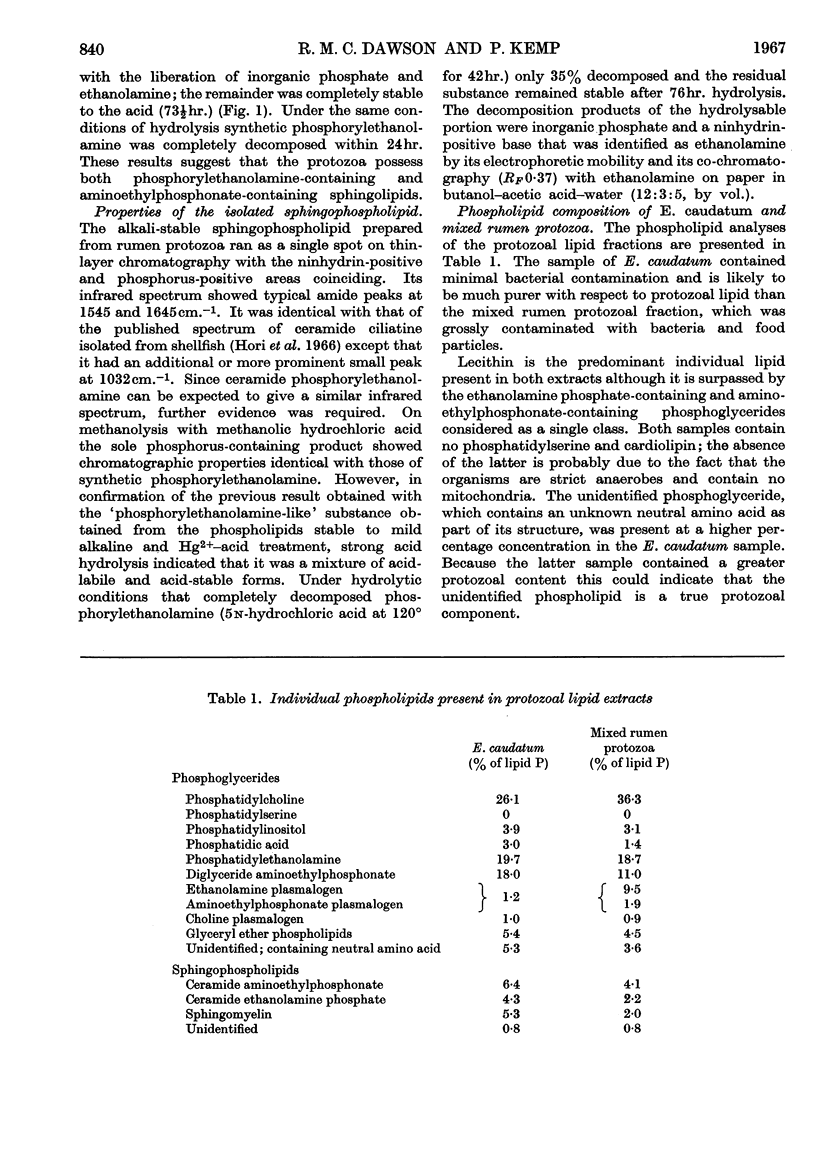
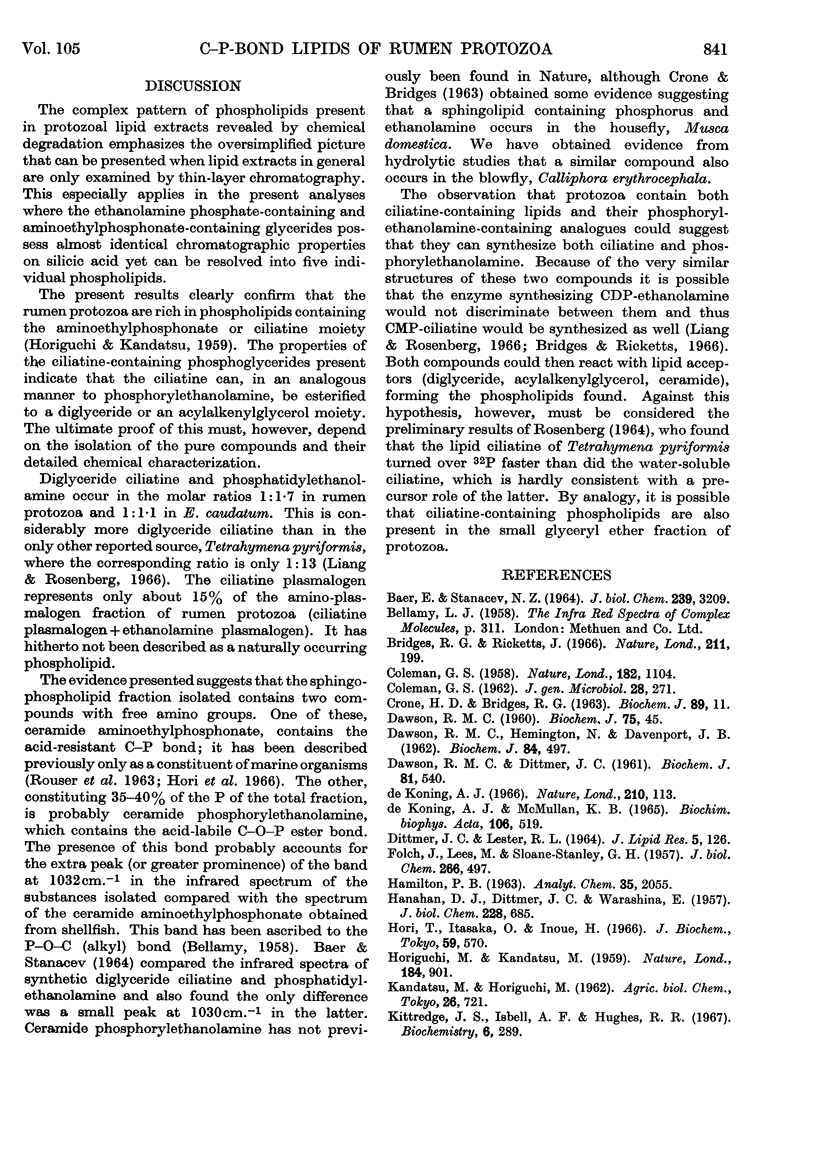
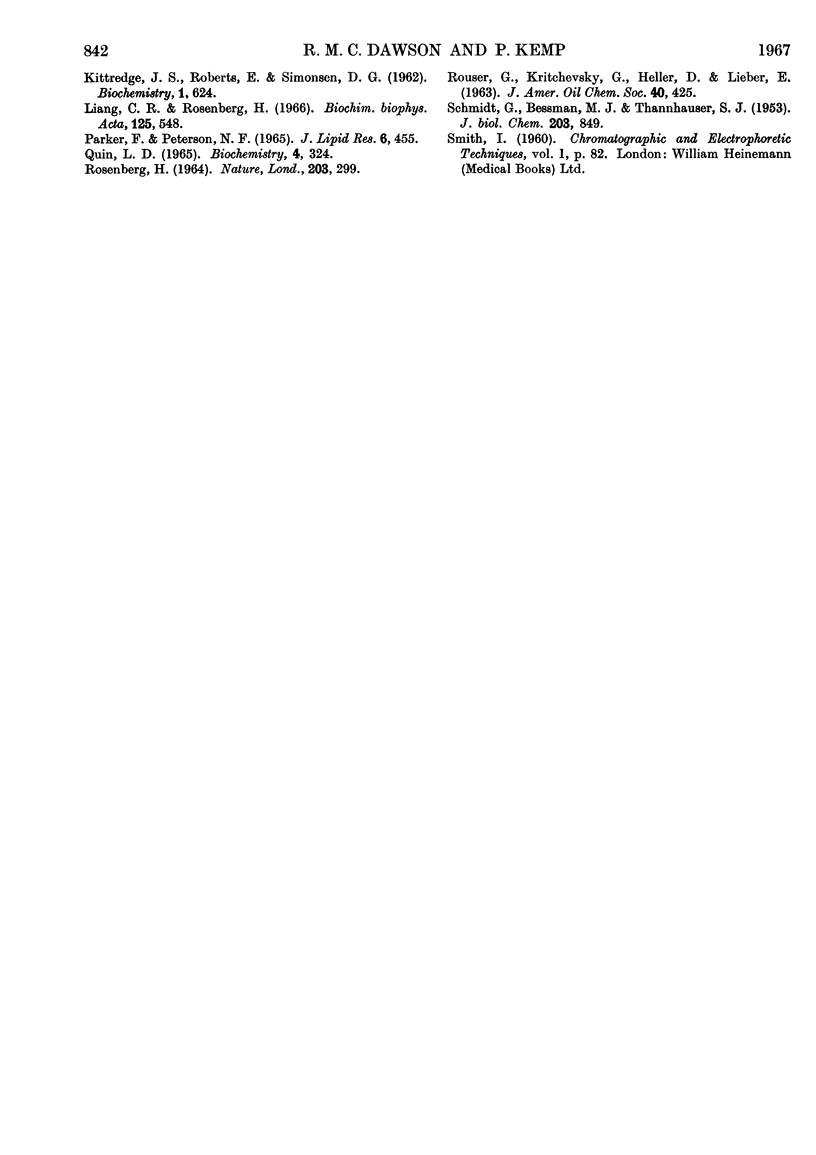
Selected References
These references are in PubMed. This may not be the complete list of references from this article.
- BAER E., STANACEY N. Z. PHOSPHONOLIPIDS. I. SYNTHESIS OF A PHOSPHONIC ACID ANALOGUE OF CEPHALIN. J Biol Chem. 1964 Oct;239:3209–3214. [PubMed] [Google Scholar]
- Bridges R. G., Ricketts J. Formation of a phosphonolipid by larvae of the housefly, Musca domestica. Nature. 1966 Jul 9;211(5045):199–200. doi: 10.1038/211199a0. [DOI] [PubMed] [Google Scholar]
- COLEMAN G. S. Maintenance of oligotrich protozoa from the sheep rumen in vitro. Nature. 1958 Oct 18;182(4642):1104–1105. doi: 10.1038/1821104a0. [DOI] [PubMed] [Google Scholar]
- COLEMAN G. S. The preparation and survival of almost bacteria-free suspensions of Entodinium caudatum. J Gen Microbiol. 1962 Jun;28:271–281. doi: 10.1099/00221287-28-2-271. [DOI] [PubMed] [Google Scholar]
- CRONE H. D., BRIDGES R. G. THE PHOSPHOLIPIDS OF THE HOUSEFLY, MUSCA DOMESTICA. Biochem J. 1963 Oct;89:11–21. doi: 10.1042/bj0890011. [DOI] [PMC free article] [PubMed] [Google Scholar]
- DAWSON R. M. A hydrolytic procedure for the identification and estimation of individual phospholipids in biological samples. Biochem J. 1960 Apr;75:45–53. doi: 10.1042/bj0750045. [DOI] [PMC free article] [PubMed] [Google Scholar]
- DAWSON R. M., HEMINGTON N., DAVENPORT J. B. Improvements in the method of determining individual phospholipids in a complex mixture by successive chemical hydrolyses. Biochem J. 1962 Sep;84:497–501. doi: 10.1042/bj0840497. [DOI] [PMC free article] [PubMed] [Google Scholar]
- DITTMER J. C., DAWSON R. M. The isolation of a new lipid, triphosphoinositide, and monophosphoinositide from ox brain. Biochem J. 1961 Dec;81:535–540. doi: 10.1042/bj0810535. [DOI] [PMC free article] [PubMed] [Google Scholar]
- DITTMER J. C., LESTER R. L. A SIMPLE, SPECIFIC SPRAY FOR THE DETECTION OF PHOSPHOLIPIDS ON THIN-LAYER CHROMATOGRAMS. J Lipid Res. 1964 Jan;5:126–127. [PubMed] [Google Scholar]
- De Koning A. J., McMullan K. B. Hydrolysis of phospholipids with hydrochloric acid. Biochim Biophys Acta. 1965 Dec 2;106(3):519–526. doi: 10.1016/0005-2760(65)90068-8. [DOI] [PubMed] [Google Scholar]
- FOLCH J., LEES M., SLOANE STANLEY G. H. A simple method for the isolation and purification of total lipides from animal tissues. J Biol Chem. 1957 May;226(1):497–509. [PubMed] [Google Scholar]
- HANAHAN D. J., DITTMER J. C., WARASHINA E. A column chromatographic separation of classes of phospholipides. J Biol Chem. 1957 Oct;228(2):685–700. [PubMed] [Google Scholar]
- HORIGUCHI M., KANDATSU M. Isolation of 2-aminoethane phosphonic acid from rumen protozoa. Nature. 1959 Sep 19;184(Suppl 12):901–902. doi: 10.1038/184901b0. [DOI] [PubMed] [Google Scholar]
- Hori T., Itasaka O., Inoue H. Biochemistry of shellfish lipid. 3. Purification and elemental analysis of ceramide aminoethylphosphonate from Corbicula complex lipid mixtures. J Biochem. 1966 Jun;59(6):570–573. doi: 10.1093/oxfordjournals.jbchem.a128345. [DOI] [PubMed] [Google Scholar]
- KITTREDGE J. S., ROBERTS E., SIMONSEN D. G. The occurrence of free 2-aminoethylphosphonic acid in the sea anemone, Anthopleura elegantissima. Biochemistry. 1962 Jul;1:624–628. doi: 10.1021/bi00910a013. [DOI] [PubMed] [Google Scholar]
- Kittredge J. S., Isbell A. F., Hughes R. R. Isolation and characterization of the N-methyl derivatives of 2-aminoethylphosphonic acid from the sea anemone, Anthopleura xanthogrammica. Biochemistry. 1967 Jan;6(1):289–295. doi: 10.1021/bi00853a045. [DOI] [PubMed] [Google Scholar]
- Liang C. R., Rosenberg H. The biosynthesis of the phosphonic analogue of cephalin in tetrahymena. Biochim Biophys Acta. 1966 Dec 7;125(3):548–562. doi: 10.1016/0005-2760(66)90043-9. [DOI] [PubMed] [Google Scholar]
- Nakamura M. Inability of decenylsuccinic acid to protect Escherichia coli against damage by freezing. Nature. 1966 Apr 2;210(5031):113–114. doi: 10.1038/210113b0. [DOI] [PubMed] [Google Scholar]
- ROSENBERG H. DISTRIBUTION AND FATE OF 2-AMINOETHYLPHOSPHONIC ACID IN TETRAHYMENA. Nature. 1964 Jul 18;203:299–300. doi: 10.1038/203299b0. [DOI] [PubMed] [Google Scholar]
- SCHMIDT G., BESSMAN M. J., THANNHAUSER S. J. The hydrolysis of L- alpha-glycerylphosphorylethanolamine. J Biol Chem. 1953 Aug;203(2):849–853. [PubMed] [Google Scholar]


